Arcturus is the brightest star in the constellation of Boötes. It is the fourth-brightest star in the night sky, yet the brightest in the northern celestial hemisphere.
Key Facts & Summary
- Arcturus, together with Spica and Denebola (Regulus) – is part of the Spring Triangle asterism, and by extension, also of the Great Diamond along with the star Cor Caroli.
- Arcturus is around 36.7 light-years / 11.26 parsecs away from our Sun.
- Arcturus is a red giant star of spectral type K0III. It is an old star with an approximate age of around 7.1 billion years.
- Observations show us that the Arcturus star has used up its core hydrogen and thus moved off the main sequence.
- Arcturus is part of the Arcturus Stream – this is a group of stars which move at a different angle and speed, then most of the other stars in the Milky Way.
- The Arcturus Stream is believed to be the remnants of a dwarf galaxy that collided with the Milky Way.
- It is estimated that Arcturus will no longer be seen with the naked eye in around one million years.
- The name “Arcturus” – is derived from the ancient Greek words “arktos” – meaning bear, and “ouros”, meaning guardian.
- Since it is visible with the naked eye, it was known to us since ancient times and many different cultures recorded the star in their writings.
- Arcturus has a mass of around 1.1 times that of our Sun.
- This star emits energy – luminosity – between 100 to 200 times greater than our sun.
- Its average temperature is around 4.000 degrees C / 7.200 degrees F – or around 73% as hot as our sun.
- Arcturus has an apparent visual magnitude of – 0.5.
- Arcturus has a radius of around 11 million miles / 18 million kilometers. It is thus around 26 times bigger than our sun.
- Arcturus has a diameter of approximately 22 million miles / 36 million kilometers.
Being the fourth-brightest star in the night sky, Arcturus, like many other stars, benefitted from many mythological associations made by the ancients.
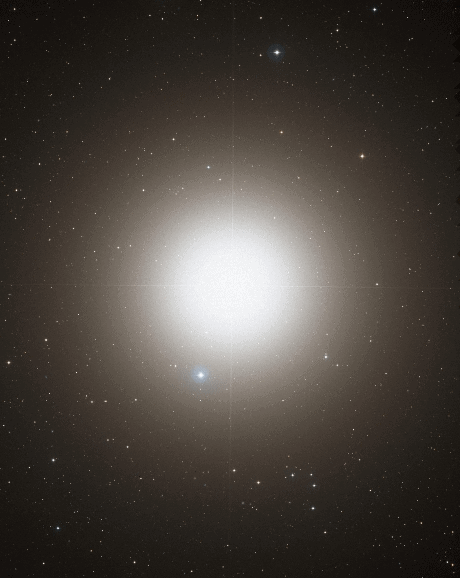
The ancient Greeks named the star Arcturus – which translates to “bear guardian.” The Greeks chose to name this star as such because they saw Arcturus as the guardian of both Ursa Major and Ursa Minor, who are constellations closely positioned near the constellation of Boötes, where Arcturus is located.
To the ancient Romans, Arcturus was associated as a harbinger of stormy/tempestuous weather. Arcturus is also one of the few stars mentioned in the bible. In the Middle Ages, the star was assigned magical properties. It was lumped in with other stars which collectively, were known as the Behenian stars.
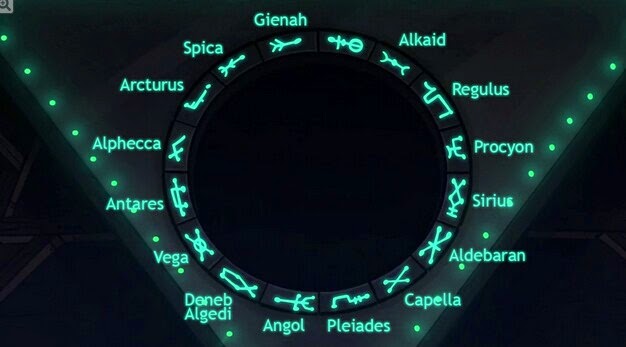
Arcturus is symbolically part of the Behenian stars, and physically part of the Arcturus Stream – a collection of 52 stars that may be the remnants of a dwarf galaxy.
Formation
Analysis suggests that Arcturus formed in the outer reaches of the Milky Way’s galactic halo around 7.1 billion years ago. Since Arcturus has a high proper motion of around 122 km / 75.5 mi per second, and it isn’t moving in the broad plane of the Milky Way-like most stars – it is strongly believed that it comes from a different galaxy.
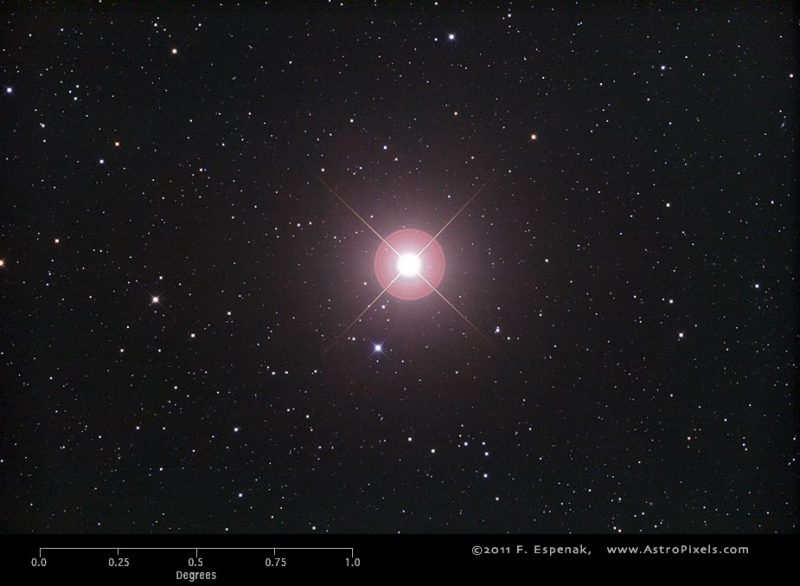
This is strongly inferred by the fact that there are around 52 other stars that share this trait. They are known collectively as Arcturus Stream. It is possible that they indeed come from a dwarf galaxy that collided with our own and was devoured.
Distance, Size, and Mass
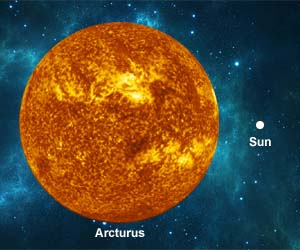
Arcturus is only 36.7 light-years / 11.26 parsecs away from our Sun. It has a radius of around 11 million miles / 18 million kilometers and a diameter of around 22 million mi / 36 million km – thus it is around 26 times bigger than our sun.
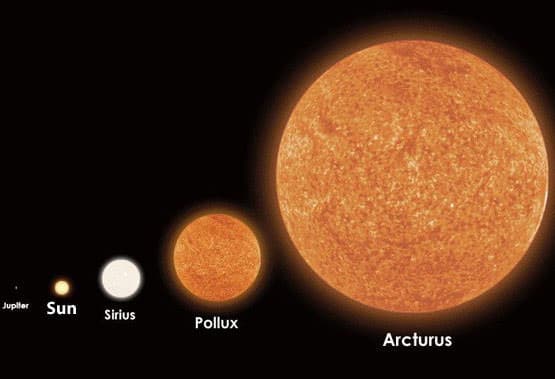
Despite being 26 times bigger than our sun, Arcturus has only 110% of the sun’s mass. However, since the star is so old it is expected that it will continue to convert helium and expand as it does so.
Other Characteristics
Since Arcturus is a red giant star – it may appear orange – its helium supplies have begun converting into oxygen and carbon. It has lower surface temperatures than our sun, at around 4.000 degrees C / 7.200 degrees F – thus it’s around 73% as hot as our sun.

Even though Arcturus is at least 100 to 200 times brighter than our sun, much of its light is radiated in infrared wavelengths.
If all the energy production is taken into account, Arcturus would be around 180 times as energetic as our sun but its temperatures point out that it is less efficient in producing energy.
Location
Arcturus is located in the constellation of Boötes. Since it is the brightest star in the constellation of Boötes, it is sometimes Latinized to Alpha Boötis. It has an apparent magnitude of – 0.05.
It is visible from both of the Earth’s hemispheres as it is located 19 degrees north of the celestial equator.
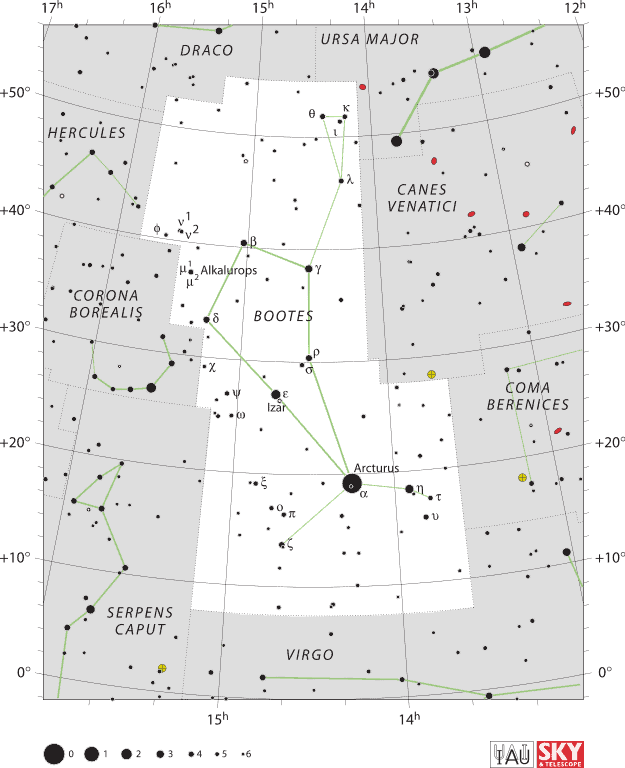
Arcturus usually culminates at midnight on the 27th of April. Arcturus is actually the first star to have been observed (other than our Sun), during the daytime.
This happened in 1635 when French astronomer Jean-Baptiste Morin, pointed his telescope and observed the star. Arcturus has also been seen at or just before sunset with the naked eye.
The Future
The future of Arcturus isn’t very good. The star is old and will continue to expand as its helium supply will be consumed. It will eventually blow off its outer layers through a supernova explosion. When this will happen, Arcturus will probably evolve into a white dwarf star and it will be surrounded by a planetary nebula.Arcturus is also moving away from us at a fast speed. It is believed that it will no longer be visible from Earth in around a million years.
Did you know?
- It is possible that Arcturus may have a companion star. This would make Arcturus a binary star if confirmed.
- Arcturus is actually traveling perpendicularly to the disk of the Milky Way.
- The light of Arcturus was used to help open the Chicago World’s Fair in 1933. In science fiction, the name Arcturus has been used several times.
- In Chinese astronomy, Arcturus is called Da Jiao – “the great horn” – since it is the brightest star in the Chinese constellation called Jiao Xiu.
- In Indian, Vedic or Sidereal astrology, Arcturus is called Swati – “very beneficent” – it is derived from the Sanskrit language.
- The Wotjobaluk Koori people of southern Australia knew Arcturus as Marpean-kurrk – “mother of Djuit – Antares.
- Arcturus was considered to represent one of the ten heavens of the Tahitian afterlife.
- The name “Arthur” is believed to be derived from Arcturus. As such, it’s possible that the myth of King Arthur was originally named for the star.
- Many ancient civilizations such as the Polynesians used Arcturus as a means of navigation.
- In ancient Mesopotamia, Arcturus was linked to the god Enlil.
- The name Arcturus may have been in use since the time of the Greek poet Hesiod or Homer – around 750 B.C.
Sources:
Image source:
- https://upload.wikimedia.org/wikipedia/commons/5/5a/Arcturus_%28optical%29.png
- https://cayelincastell.com/wp-content/uploads/2017/10/behenian-star-glyphs.jpg
- https://en.es-static.us/upl/2017/05/arcturus-fred-espenak-2011-e1557323387719.jpg
- https://www.solarsystemquick.com/universe/arcturus_compared_to_sun.jpg
- https://www.universetoday.com/wp-content/uploads/2013/03/arcturus-size-comp_TR.jpg
- https://www.upr.org/sites/upr/files/styles/medium/public/201904/GJ504_Star_Chart.jpg
- https://upload.wikimedia.org/wikipedia/commons/thumb/4/47/Bo%C3%B6tes_IAU.svg/625px-Bo%C3%B6tes_IAU.svg.png
